Magnetic Effect Versus Thermal Effect on Quark Matter with a Running Coupling at Finite Densities∗
Li Yang(杨丽)and Xin-Jian Wen(温新建)
Institute of Theoretical Physics,Shanxi University,Taiyuan 030006,China
1 Introduction
The properties of the quark matter are of most importance in understanding many physical aspects of nature,such as the quark gluon plasma in the big bang of the early universe,the possible structure in the core of compact objects,and the hadronic quark phase transition in experiments,where the high temperature and high densities characterize the extreme conditions.Recently,the study of the quark matter phase diagram is extended to a strong magnetic field,[1−3]and further extended to a parallel electric and magnetic field background.[4]There is a possibility that the early universe contained a strong magnetic field.Present investigations in experiments or theory propose that a strong magnetic field could exist in the core of neutron stars and in the noncentral heavy ion collision experiments in the Relativistic Heavy Ion Collider or the Large Hadron Collider(LHC).[5]The magnitude of the magnetic field can reach the order of 1019G or higher in these conditions,which is much stronger than the value 1016G in some magnetars.[6]Theoretically,the physical upper limit of the strong magnetic field can be understood as large as 1018G by comparing the magnetic and gravitational energies.[7]The magnetic field in the interior of stars could go up to the maximum strengths of(1018−1020)G.[5,8]In the experiments at the LHC/CERN energy,it is possible to produce a magnetic field of 5×1019G,[5,9]where all the flavors could be lying in the lowest Landau level(LLL).These magnetic fields are short-lived at very high energies,but play an important role in understanding the equation of state of compact stars,the chiral magnetic effect,and the possible signatures of strong CP violation in experiments.[10−13]
In addition to the influence on the stability of the quark matter,the presence of the external magnetic field will produce the temperature-magnetic phase diagram for QCD matter.[14−15]The isospin symmetry breaking is determined by both the temperature and the non-zero magnetic field.[16]The chiral symmetry phase transition will be intensively affected by the magnetic catalysis effect at finite temperature.The spins of the quarks are aligned along the direction of the induced magnetic field according to their helicities.As a result,the spin polarization effect is enhanced and the quark-antiquark pair couples strongly as the magnetic field increases.
In previous works,we have studied the properties of two- flavor quark matter at zero temperature within the NJL model with a magnetic field dependent running coupling.It was shown that the dynamical quark masses as functions of the magnetic field strength are not monotonous in the fully chirally broken phase and the magnetized quark matter with the running coupling is more stable than that of the conventional constant coupling case.[27]In this paper,our aim is to investigate the influence of the magnetic effect and thermal effect on twoflavor quark matter under the strong magnetic field at if nite densities.
This work is organized as follows.In Sec.2,a brief review of the NJL model description of quark matter in a strong magnetic field is provided.The magnetic- fielddependent running scalar coupling in the SU(2)version is introduced as well as the model parameters in the computation.In Sec.3,the numerical results and discussion are given with a detailed analysis of the competition of the magnetic effect and the thermal effect.The last section is a short summary.
2 Thermodynamics of Magnetized Quark Matter in SU(2)NJL Model
The Lagrangian density of the two- flavor NJL model in a strong magnetic field is given as

whereψrepresents a flavor isodoublet(uanddquarks),the covariant derivativeDµ=∂µ−iqiAµrepresents the coupling of the quarks to the electromagnetic field,while→τare isospin Pauli matrices. A sum over flavor and color degrees of freedom is implicit.In the mean- field approximation,[28]the dynamical quark mass is related to the condensation terms as

where the quark condensates includeuanddquark contributions as The constituent mass depends on both condensates.Therefore,the same massMu=Md=Mis available foruanddquarks.Thecontribution from the quark flavoriis

银蛇欢舞辞旧岁,金马奔腾迎新春,在这辞旧迎新的日子里,保定市力达塑业有限公司通过《中国水利》杂志向各界朋友致以节日的问候,祝大家在新的一年里身体健康、万事如意、阖家幸福!

whereaki=2−δk0andkiare respectively the degeneracy label and the Landau quantum number.The dimensionless quantityxiis defined asxi=M2/(2|qi|B).The fermion distribution function is

The quark condensation is greatly strengthened by the factor|qiB|together with the dimension reductionD− 2.[31−32]
The total thermodynamic potential density in the mean field approximation reads

where the first term is the interaction term.In the second term,the quantity is defined asThe vacuum contribution to the thermodynamic potential is

where the quantityϵΛis defined asThe ultraviolet divergence in the vacuum partof the thermodynamic potential is removed by the momentum cutoff.The magnetic field and medium contributions are respectively


According to the formulaSi= −(∂Ωi/∂T),we can obtain the entropy density from the flavoricontribution[30]

Under strong magnetic fields,the system total pressure should be a sum of the matter pressure and the field pressure contribution.[29,33]But due to the requirement that the pressure should vanish in vacuum,the magnetic field termB2/2 is automatically absent in the normalized thermodynamic quantities.
For asymmetric quark matter we should consider theβequilibrium by including the electron contribution under strong magnetic fields,where the charge neutrality condition 2nu−nd−3ne=0 is attained. The electron chemical potential,which is not independent and related to the quark chemical potential meet the conditions:µe=µd−µu.The thermodynamical quantities can√ be obtained by settingNc=1,M=meandThe total pressure withβequilibrium should be a summation going over theu,dquarks and electrons as

According to the fundamental thermodynamic relation,the free energy density and the energy density at finite temperature are

In principle,the interaction coupling constant between quarks should be solved by the renormalization group equation,or it can be phenomenologically expressed in an effective potential dependent on environmental variables.[34−36]In the infrared region,the nonperturbative effect becomes important and the dynamical gluon mass represents the confinement feature of QCD.[37]In the presence of a strong magnetic field,it is well known that the interaction constant shows an obvious decreasing behavior in addition to the enlargement of the gluon mass.[38]For suffciently strong magnetic fieldseB≫Λ2QCD,it is reasonable to express the coupling constantαsrelated to the magnetic field.[26,31]Motivated by the work of Miransky and Shovkovy,[31]the similar ansatz of the magnetic- field-dependent coupling constant is introduced in the SU(2)NJL models.[25]

with the parameters ΛQCD=200 MeV,α=2,β=0.000327.
3 Numerical Results and Discussion
In this work we consider the two- flavor quarks inβequilibrium state.Therefore the different chemical potentials ofuanddquarks should be solved,even though their dynamical masses are common from Eq.(2).In Fig.1,the dynamical masses ofuanddquarks are shown versus their chemical potentials at a fixed magnetic fieldB=2×1019G.The three different temperaturesT=(50,100,150)MeV are marked respectively by solid,dashed,and dotted lines from outside to inside.It can be clearly seen from the figure that the lower the temperature,the larger the critical chemical potential at which the firstorder phase transition happens.As the chemical potential increases,the dynamical masses decrease gradually until their masses approach to the chiral limit,which indicates a fully chiral symmetry restored phase.

Fig.1 Dynamical masses of u and d quarks versus the chemical potential at different temperatures and a fixed magnetic field.
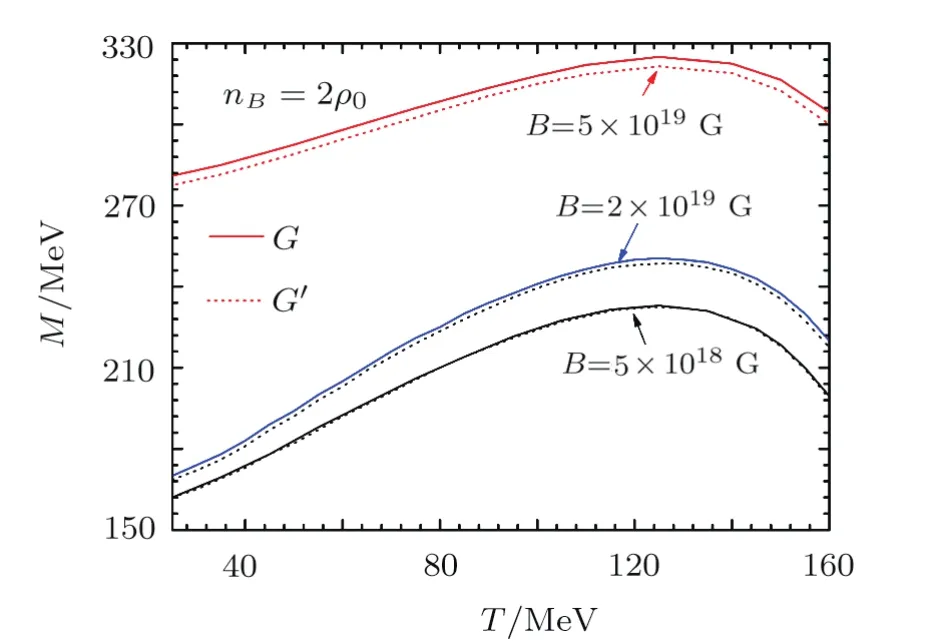
Fig.2 (Color online)Dynamical quark mass versus the temperature for the fixed coupling G and the running coupling G′(eB)at a fixed density and three different magnetic fields.
In Fig.2,we show that the dynamical quark masses vary with the temperature at a fixed densitynB=2ρ0.The three different magnetic fieldsB=5 × 1018G,B=2×1019G,B=5×1019G are marked respectively by black,blue,and red lines.For comparisons,the two kinds of the interactionsGandG′(eB)are taken in computations.It can be seen that the magnetic- fielddependent running couplingG′(eB)has a light influence on the values of the dynamical masses.The minor difference between the two kinds of couplings is expected to be enlarged under higher magnetic field.
In order to study the spin polarization,the degeneracy factor is neglected.The Landau level quantum number is 2ki=2n+1−s.Thes= ±1 stand for the spin up and down respectively.We define the polarization parameter as[30]

Charged particles in a magnetic field have a tendency to align their spin orientation along the direction of the external field.In Fig.3,the entropy per baryon is shown as a function of the temperature at different magnetic fieldsB=(1×1018,2×1019,5×1019)G from top to bottom.The entropy per baryon increases monotonically as the temperature increases,which is fully in agreement with the third law of thermodynamics.From the figure we can find that the magnetic field has a less influence on the entropy per baryon.The entropy behavior is mainly dominated by the temperature as expected.At the fixed temperature in Fig.5,the entropy per baryon is given as a function of the magnetic field.It is again verified that the entropy keeps constant for a given temperature,and feels less influence of the magnetic field below 1.5×1019G,at the field beyond which the entropy per baryon will have a slight oscillation behavior at lower temperature.

Fig.3 The entropy per baryon versus the temperature is shown at the magnetic field B=1018G,2×1019G,5×1019G and the density nB=2ρ0.
In Fig.4,we show the quark spin polarizations versus the magnetic fields at different temperaturesT=25 MeV,150 MeV and the densitiesnB=2ρ0,3ρ0withρ0=0.16 fm−3. The spin polarization effect is more noticeable for the low temperatureT=25 MeV and the densitynB=2ρ0indicated by the dashed line.The maximum of the absolute value is|Δi|=1.Specially at the magnetic field larger than 1019G,a lot of quarks are collected into the LLL,which is indicated by the two horizonal lines labeled by Δu=+1 and Δd= −1.However,at a higher temperature,the thermal effect makes the lines gradually concentrate to the central region and the spin polarization effect becomes weaker and weaker.

Fig.4 Spin polarizations Δuand Δdversus the magnetic field at two different temperatures T=25,150 MeV and two different density nB=2ρ0,3ρ0.
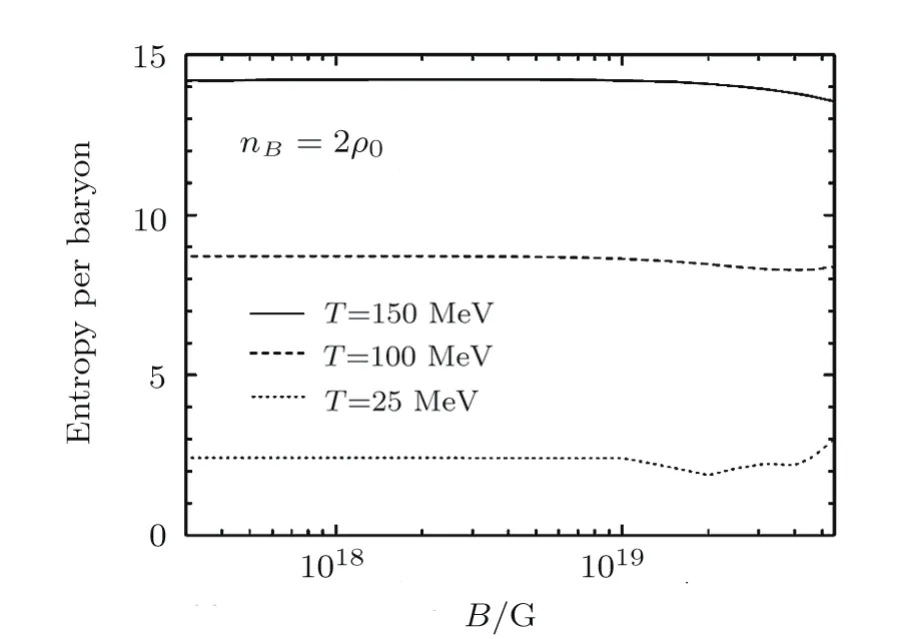
Fig.5 The entropy per baryon versus the magnetic field is shown at three different temperatures T=(25,100,and 150)MeV and the density nB=2ρ0.

where the signs“+”and“−”refer the positively and negatively charged particles respectively.is the number density in the LLL fori-type quarks.So the absolute value of the spin polarization is directly related to the ratio of the number density on the LLL and the total density,then all quarks are in the LLL.In Fig.6,the ratiosofu-andd-quarks versus the temperature are shown.The different densitiesnB=2ρ0,3ρ0are represented by solid and dotted lines
In a strong magnetic field,the each Landau level is occupied by the particles with two spin-directions in addition to the zeroth Landau level,which is not spin-degenerated.So in Eq.(17),the difference of the number density is directly denominated by the zeroth Landau level,namely the LLL.For positively charged quarks,the LLL is occupied by the spin-up particle,and for negatively charged quarks by the spin-down particle.Now the spin polarization in Eq.(17)can be simplified by a ratio of the number density as respectively.The ratio/nuofuquark is larger than that of thedquark because of the larger electric charge ofuquarks.Moreover,it is easily seen that the ratio is larger at a lower temperature and a lower baryon number density,where the magnetic field becomes very important.However,as the temperature increases,the ratio will decrease and the spin polarization becomes weaker until the thermal effect dominates the structure of the matter.

Fig.6 The particle number density ratios/nifor uand d-quarks versus the temperature are indicated by solid and dotted lines respectively.For a given magnetic field B=5×1018G,the two baryon densities nB=2ρ0,3ρ0are studied.
For three values of the magnetic field,we show the ratioatnB=2ρ0in Fig.7,where we can find two extreme cases.The first case is under the magnetic field of the order 1018G indicated by the red lines,where the polarization effect is not important in the whole range of temperature.On the contrary,the second case is in a stronger magnetic field of order 5×1019G,where the polarization effect will become more important.In particular,the ratiois very close to 1 for lower temperatureT=25 MeV,where a mount of quarks are in the LLL.Therefore the corresponding LLL approximation is exactly suitable for the condition of the strong magnetic if elds and low temperature.
Undoubtedly,the spin polarization is enhanced by the magnetic field larger than 1019G and the quarks would be in a uniform arrangement with the same spin orientation.The fully polarized state means that all quarks would be lying in the LLL.In Fig.8,we show the ratioversus the magnetic field at three temperaturesT=(25,100,150)MeV respectively andnB=2ρ0.From the figure,we can see that the quark number density ratiois an increasing function of the magnetic field:from the non-polarized stateto the fully polarized stateindicated by the solid horizonal line.In other words,the quark number in the zeroth Landau level has a remarkable increase at the magnetic field about 1019G.When the magnetic field reached the threshold value,almost alluquark are lying in the LLL.The threshold value of the magnetic field foris larger because ofdquark’s smaller electric charge.
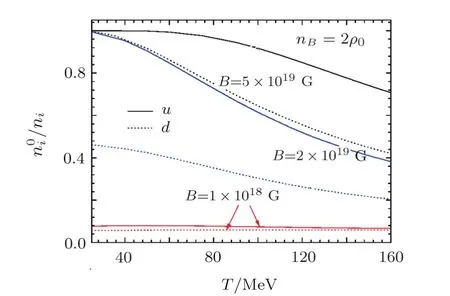
Fig.7 The ratio /nifor u-,d-quark versus the temperature for nB=2ρ0and B=(1018,2×1019,5×1019)G from bottom to top marked by red,blue,and black lines respectively.

Fig.8 The quark number density ratio n0i/niof u,d quark versus the magnetic field B is shown at T=(25,100,150)MeV respectively.The baryon number density is fixed as nB=2ρ0.
The free energy per baryon is an important quantity to characterize the stability of the quark matter.In the SU(2)NJL model,Fig.9 gives the energy and free energy per baryon versus baryon number density for different temperatures at theB=1×1018G.In the small density region,the free energy per baryon on left panel is clearly an increasing function of the number density,while the energy per baryon is a decreasing function.In the middle range of the density,there is a local minimum value for both the energy and free energy.At a given density,the higher temperature will lead to a smaller free energy and a larger energy per baryon.
To illustrate the fundamental thermodynamic relationE=F+TSin fluenced by the magnetic effect and thermal effect,we show the energy and free energy per baryon as a function of the temperature for three different magnetic fields in Fig.10.It is obvious that the energy is an increasing function of temperature whereas the free energy decreases with increasing temperature.Importantly,we can find that stronger magnetic field will lead to a lower free energy per baryon,which means that a proper strong magnetic field can enhance the stability of quark matter.However,we should notice that for more higher magnetic fields,the quark matter may be located in the fully chirally broken phase,where the calculation would give a larger free energy.The relevant discussion at zero temperature can be found in Fig.4 in Ref.[39].According to the fundamental thermodynamic relation,the energy and free energy coincide with each other at zero temperature.

Fig.9 The free energy per baryon and energy per baryon at T=(50,100,150)MeV as a function of the baryon number density for B=1×1018G.
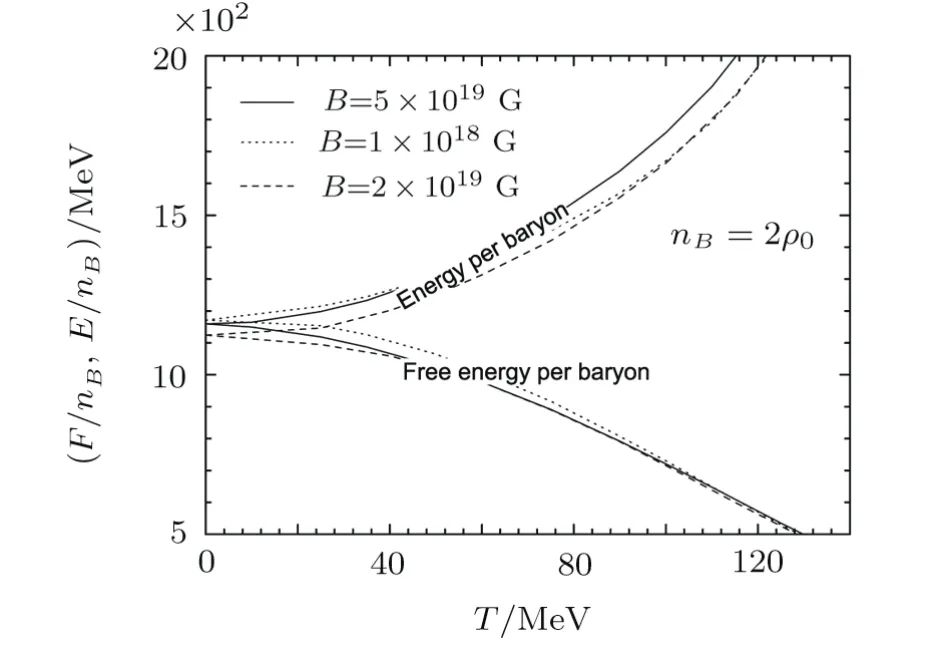
Fig.10 The free energy and the energy per baryon versus the temperature at the four different magnetic field values and the density nB=2ρ0.
The free energy versus the temperature is shown at a if xed densitynB=2ρ0and two different magnetic fieldsB=1×1018andB=5×1019in Fig.11.The constant couplingGand the running couplingG′(eB)are indicated by the solid and dotted lines respectively.The effect of the magnetic field can hardly be seen from the very close lines.Especially at the fieldB=1×1018G,the two red lines forGandG′(eB)overlap.But it can be numerically concluded that the quark matter is more stable under the running couplingG′(eB)in larger magnetic field.At both the low temperature and the strong magnetic field,the running coupling effect becomes more clear.
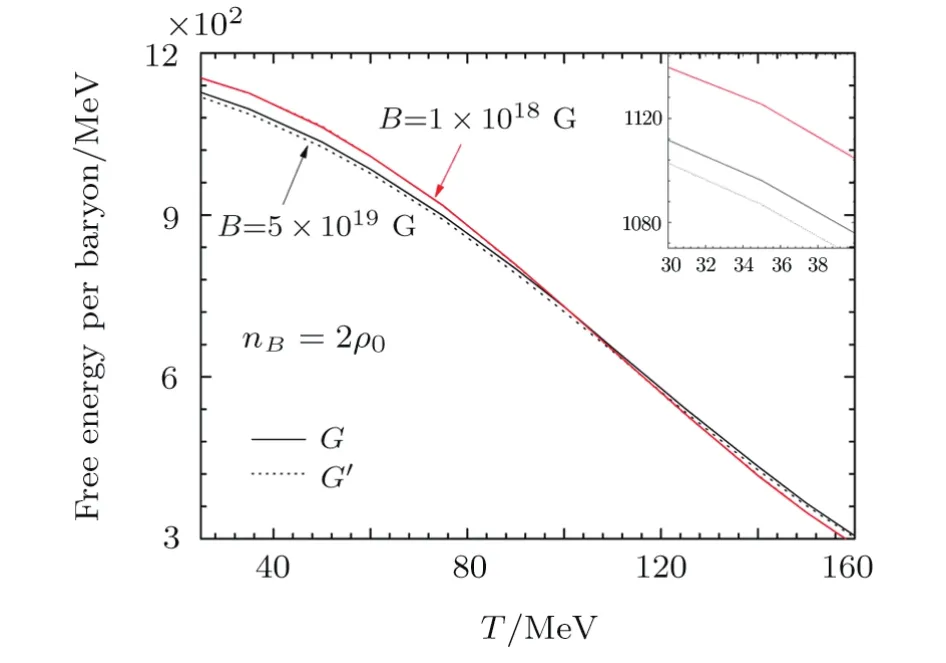
Fig.11 The free energy per baryon versus the temperature at two different magnetic field values for the couplings G and G′(eB).
4 Summary
In this paper we have studied the magnetic effect and the thermal effect on the quark matter in a strong magnetic field within the SU(2)NJL model.The interaction is described by the magnetic- field-dependent coupling.As the temperature or density increases,the chiral restoration transition happens.By comparison with the constant coupling case,the dynamical masses change a little under the running couplingG′(eB).The spin polarization is shown as a function of the magnetic field.It can be further understood by the ratio of the quark number in the LLL and the total quark number.We focus on the discussion of the competition of the magnetic effect and thermal effect by investigating the spin polarization,the ratioand the entropy per baryon.In a suffcient strong magnetic field,a lot of quarks are lying in the LLL due to the large degeneracy factor|eB|.But higher temperatures will excite the quarks to higher Landau levels,and eventually make the magnetic effect less and less important.It is graphically demonstrated that for the magnetic field range from 1017G to 1019G,the quark matter would undergo a transition from the non-polarized state to fully polarized state,where all quarks are in the LLL.Because theuquark has a larger charge thandquark,it is earlier collected in the LLL as the magnetic field increases.Finally,we show the energy and the free energy per baryon varying with the density,the temperature,and the magnetic field.It is found that the magnetic field of a proper value can lower the free energy per baryon and enhance the stability of quark matter to some extent.
[1]V.A.Miransky and I.A.Shovkovy,Phys.Rep.576(2015)1;J.O.Andersen,W.R.Naylor,and A.Tranberg,Rev.Mod.Phys.88(2016)025001.
[2]V.P.Gusynin,V.A.Miransky,and I.A.Shovkovy,Phys.Rev.Lett.73(1994)3499;E.J.Ferrer and V.de la Incera,Phys.Lett.B 481(2000)287;N.Mueller and J.M.Pawlowski,Phys.Rev.D 91(2015)116010.
[3]R.G.Felipe and A.P.Martínez,J.Phys.G 36(2009)075202;R.González Felipe,D.Manreza Paret,and A.Pérez Martínez,Eur.Phys.J A 47(2011)1.
[4]M.Ruggieri and G.X.Peng,Phys.Rev.D 19(2016)094021.
[5]D.E.Kharzeev,L.D.McLerran,and H.J.Warringa,Nucl.Phys.A 803(2008)227.
[6]C.Thompson and R.C.Duncan,Astrophys.J.392(1992)L9.
[7]G.Chanmugam,Annu.Rev.Astron.Astrophys.30(1992)143;D.Lai,Rev.Mod.Phys.73(2001)629.
[8]L.Dong and S.L.Shapiro,Astrophys.J.383(1991)745.
[9]V.Voronyuk,V.D.Toneev,W.Cassing,E.L.Bratkovskaya,V.P.Konchakovski,and S.A.Voloshin,Phys.Rev.C 83(2011)054911.
[10]K.Fukushima,D.E.Kharzeev,and H.J.Warringa,Phys.Rev.D 78(2008)074033;D.E.Kharzeev and H.J.Warringa,Phys.Rev.D 80(2009)034028.
[11]D.Kharzeev,R.D.Pisarski,and M.H.G.Tytgat,Phys.Rev.Lett.81(1998)512;D.Kharzeev and R.D.Pisarski,Phys.Rev.D 61(2000)111901(R);K.Buckley,T.Fugleberg,and A.Zhitnitsky,Phys.Rev.Lett.84(2000)4814;S.A.Voloshin,Phys.Rev.C 62(2000)044901;70(2004)057901;D.Kharzeev,Phys.Lett.B 633(2006)260;D.Kharzeev and A.Zhitnitsky,Nucl.Phys.A 797(2007)67.
[12]D.E.Kharzeev,Nucl.Phys.A 830(2009)543c;Ann.Phys.(N.Y.)325(2010)205;K.Fukushima,D.E.Kharzeev,and H.J.Warringa,Nucl.Phys.A 836(2010)311;Phys.Rev.Lett.104(2010)212001.
[13]V.Skokov,A.Illarionov,and V.Toneev,Int.J.Mod.Phys.A 24(2009)5925.
[14]A.J.Mizher,M.N.Chernodub,and E.S.Fraga,Phys.Rev.D 82(2010)105016.
[15]R.L.S.Farias,V.S.Timóteo,S.S.Avancini,M.B.Pinto,and G.Krein,arXiv:1603.03847[hep-ph].
[16]S.Nam and C.W.Kao,Phys.Rev.D 83(2011)096009.
[17]D.P.Menezes,M.B.Pinto,and C.Providência,Phys.Rev.C 91(2015)065205.
[18]D.Ebert,K.G.Klimenko,M.A.Vdovichenko,and A.S.Vshivtsev,Phys.Rev.D 61(1999)025005.
[19]P.G.Allen and N.N.Scoccola,Phys.Rev.D 88(2013)094005.
[20]T.Inagaki,D.Kimura,and T.Murata,Prog.Theor.Phys.111(2004)371.
[21]A.G.Grunfeld,D.P.Menezes,M.B.Pinto,and N.N.Scoccola,Phys.Rev.D 90(2014)044024.
[22]F.Preis,A.Rebhan,and A.Schmitt,J.High Energy Phys.03(2011)033;Lect.Notes Phys.871(2013)51.
[23]G.S.Bali,F.Bruckmann,G.Endrodi,Z.Fodor,S.D.Katz,S.Krieg,A.Schafer,and K.K.Szabo,J.High Energy Phys.1202(2012)044;G.S.Bali,F.Bruckmann,G.Endrodi,Z.Fodor,S.D.Katz,S.Krieg,and A.Schafer,Phys.Rev.D 86(2012)071502(R).
[24]V.Bernard and U.G.Meissner,Annals Phys.206(1991)50;M.B.Pinto,Phys.Rev.D 50(1994)7673.
[25]R.L.S.Farias,K.P.Gomes,G.Krein,and M.B.Pinto,Phys.Rev.C 90(2014)025203.
[26]M.Ferreira,P.Costa,O.Lourenco,T.Frederico,and C.Providência,Phys.Rev.D 89(2014)116011.
[27]C.F.Li,L.Yang,X.J.Wen,and G.X.Peng,Phys.Rev.D 93(2016)054005.
[28]C.Ratti,Europhys.Lett.61(2003)314;M.Buballa and M.Oertel,Phys.Lett.B 457(1999)261.
[29]D.P.Menezes,M.B.Pinto,S.S.Avancini,A.P.Martínez,and C.Providência,Phys.Rev.C 79(2009)035807;M.Ferreira,P.Costa,D.P.Menezes,C.Providência,and N.N.Scoccola,Phys.Rev.D 89(2014)016002.
[30]S.S.Avancini,D.P.Menezes,and C.Providência,Phys.Rev.C 83(2011)065805.
[31]V.A.Miransky and I.A.Shovkovy,Phys.Rev.D 66(2002)045006.
[32]T.Kojo and N.Su,Nucl.Phys.A 931(2014)763.
[33]J.L.Noronha and I.A.Shovkovy,Phys.Rev.D 76(2007)105030.E.J.Ferrer,V.de la Incera,J.P.Keith,I.Portillo,and P.L.Springsteen,Phys.Rev.C 82(2010)065802;L.Paulucci,E.J.Ferrer,V.de la Incera,and J.E.Horvath,Phys.Rev.D 83(2011)043009.
[34]J.L.Richardson,Phys.Lett.B 82(1979)272.
[35]M.Sinha,X.G.Huang,and A.Sedrakian,Phys.Rev.D 88(2013)025008.
[36]J.F.Xu,G.X.Peng,F.Liu,D.F.Hou,and L.W.Chen,Phys.Rev.D 92(2015)025025.
[37]A.A.Natale,Nucl.Phys.B Proc.Suppl.199(2010)178.
[38]E.J.Ferrer,V.de la Incera,and X.J.Wen,Phys.Rev.D 91(2015)054006.
[39]X.J.Wen,S.Z.Su,D.H.Yang,and G.X.Peng,Phys.Rev.C 86(2012)034006.
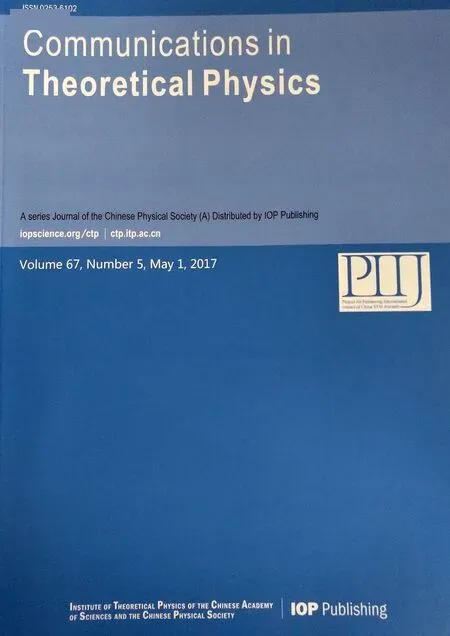 Communications in Theoretical Physics2017年5期
Communications in Theoretical Physics2017年5期
- Communications in Theoretical Physics的其它文章
- Elastic Deformation Analysis on MHD Viscous Dissipative Flow of Viscoelastic Fluid:An Exact Approach
- Inverse Scattering Transform of the Coupled Sasa–Satsuma Equation by Riemann–Hilbert Approach∗
- Borromean Windows for Three-Particle Systems under Screened Coulomb Interactions∗
- Isotopic Effects on Stereodynamics of the C++H2→ CH++H Reaction∗
- Entropy Generation Analysis in Convective Ferromagnetic Nano Blood Flow Through a Composite Stenosed Arteries with Permeable Wall
- Effects of Interfaces on Dynamics in Micro-Fluidic Devices:Slip-Boundaries’Impact on Rotation Characteristics of Polar Liquid Film Motors∗
